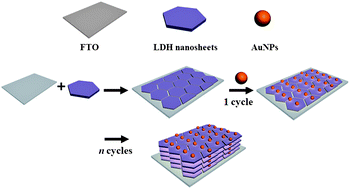This paper reports the fabrication of layered double hydroxide nanosheets (LDH nanosheets)/Au nanoparticles (AuNPs) ultrathin films (UTFs) via the layer-by-layer (LBL) assembly technique, and their electrocatalytic performance for the oxidation of glucose was demonstrated. UV-vis absorption spectra show the uniform growth of the UTFs and the enhancement of interlayer plasmon coupling of AuNPs upon increasing deposition cycle. The XRD results indicate that the (LDH/AuNPs)n UTFs possess long-range order stacking in the normal direction of the substrate, with AuNPs accommodated between the LDH nanosheets as a monolayer arrangement. SEM, TEM and AFM images reveal a high dispersion of AuNPs on the surface of the LDH nanosheets without aggregation. The electrochemical behavior of the UTF modified fluorine-doped tin oxide (FTO) electrode was studied by cyclic voltammetry and electrochemical impedance spectroscopy. The (LDH/AuNPs)n UTF shows improved electron transfer kinetics, owing to the formation of electron tunneling junctions resulting from the interlayer plasmon coupling. This leads to new channels for facilitating electron transfer within the UTFs. In addition, the (LDH/AuNPs)8electrode displays significant electrocatalytic performance for glucose with a linear response range (50 μM–20 mM), low detection limit (10.8 μM), high sensitivity (343 μA mM−1 cm−2), good stability and reproducibility. Therefore, this work provides a feasible method to immobilize metal nanoparticles using the LDH nanosheet as a 2D matrix, which is promising for the development of enzyme-free sensors.
